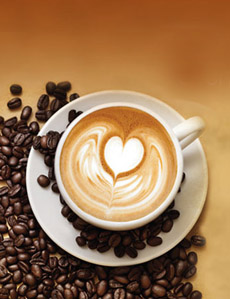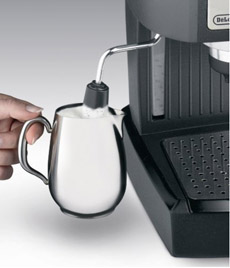February 14, 2014 at 7:54 am
· Filed under Coffee & Tea, Recipes, Tip Of The Day, Valentine's Day

Make this for your Valentine. Photo courtesy
Amoretti. |
|
Ever wish you could create latte art? Today’s the day to practice a heart design in your latte.
We love latte art: animals, cross-hatches, ferns (rosettes), hearts, flowers. The ephemeral milk foam adds a smile to the coffee.
We looked for a book on latte art, but surprise: There isn’t a dedicated book in print (there is, however, LatteArt.org). So we turned to the experts at DeLonghi, whose coffee and espresso machines are coveted by lovers of espresso, cappuccino and latte.
They in turn reached out to Laila Ghambari, Director of Coffee at Cherry Street Coffee House in Seattle—the home of American latte art. Here are her tips:
The micro-foam is a crucial element in creating the perfect latte art. Use a milk foaming machine that is able to produce rich, thick, long-lasting foam.
Use whole or 2% milk. More milk fat equals more creaminess.
Add air to the milk by bringing the steam wand tip to the surface of the milk (not beneath). Remember that NO air will just create hot milk and TOO MUCH air will make your milk bubbly.
|
|
Make sure that when you are steaming your milk that the milk is spinning. You can achieve this by tilting the pitcher, which allows for the air and milk to blend together.
You need to steam the milk to a smooth, creamy texture. It should look cold cream or wet paint.
Once the milk is steamed, swirl it around to make sure the milk and foam are incorporated, not separated.
|
|
TO MAKE A HEART
TILT. Start by tilting the cup of espresso 45 degrees.
TOUCH. Think of the steamed milk in the pitcher as the “pencil” and the espresso in the cup as the “canvas.” To create art you must touch the pencil to the canvas. Tilting the cup enables the pencil to touch the canvas much sooner than if the cup is upright (in which case you could only reach the canvas when the cup is full).
POUR. Start pouring up high, further away from the cup, so that the milk has a higher velocity and drops below the espresso. When the cup is full enough that the coffee soon start spilling out of the 45 degree tilt, drop the tip of the pitcher to the surface of the milk.
POUR. Keep pouring in the same spot as you fill the cup (make sure you are tilting the cup back to upright, so not to spill). This will create a large white circle in the cup.
PULL. To make a heart, pull the pitcher away from the surface of the milk to thin the stream before you “slice” the circle. Pour the milk through the center of the circle, which will split it into two halves. It will immediately start to take the shape of a heart.
|
|

A DeLonghi cappuccino machine close-up on the steaming wand and frothing pitcher. Photo courtesy DeLonghi.
|
See it done in this video.
THE HISTORY OF LATTE ART
Latte art was enabled by the development of microfoam, created by the steam wand of a cappuccino machine, used to foam a pitcher of milk. The combination of the crema atop the cup of espresso and velvety microfoam allows patterns to be made. (Note that other types of milk steamers/foamers do not create microfoam.)
Latte art in the United States developed in the Seattle coffee culture of the 1980s and 1990s. By 1989 the heart pattern was a signature at David Schomer’s Espresso Vivace and the rosette pattern followed, based on a photograph Schomer saw of latte art in an Italian café.
FOOD TRIVIA
Cappuccino is named after the color of the hooded robes worn by monks and nuns of the Capuchin order. The red-brown color was a common descriptor in 17th-century Europe.
HOW DOES LATTE DIFFER FROM OTHER ESPRESSO DRINKS?
What’s the difference between latte and cappuccino? What’s a macchiato? Check out our Espresso glossary for the different type of espresso drinks.
|
Please follow and like us:
Permalink
Comments are closed.

